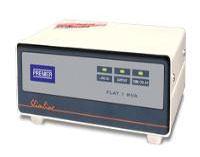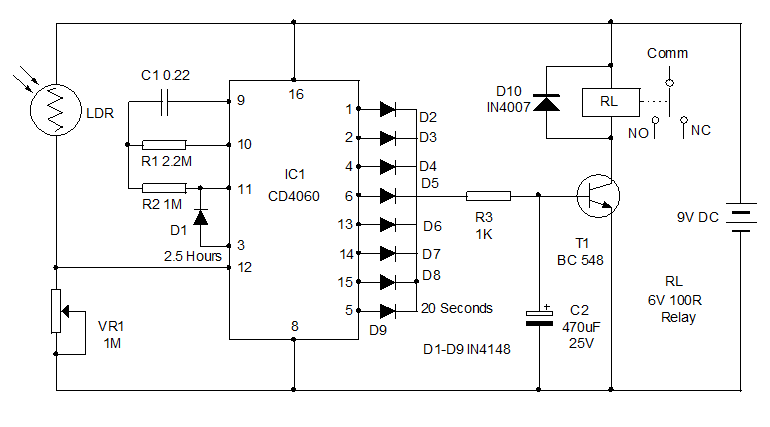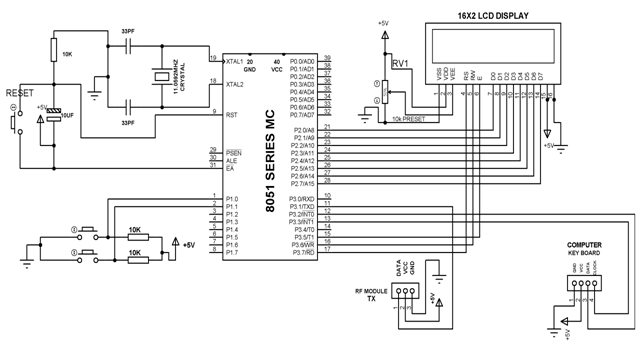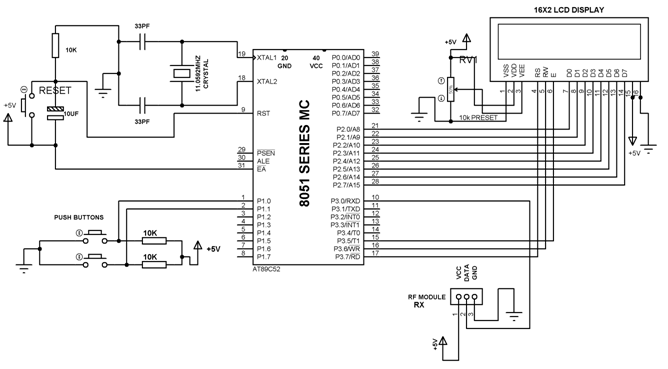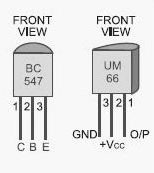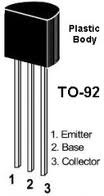What is Cell Phone Detector?
We are most familiar with cell phone active detectors. The cell phone detectors are mostly hand and pocket-size mobile transmission detectors. It can sense the presence of an activated mobile phone from a distance of one and a half meters. So it can be used to prevent use of mobile phones in examination halls, confidential rooms, etc.
Use of Cell Phone Detector:
It is also useful for detecting the use of mobile phone for spying and un-authorized video transmission. Certain places where the use of mobile phones are not allowed like exam hall, temple, offices and theaters, in those places to detect and restrict the use of mobile phones this proposed system is very helpful. The circuit can detect the incoming and outgoing calls, SMS and video transmission even if the mobile phone is kept in the silent mode.
How Cell Phone Detector Works:
The moment the bug detects RF transmission signal from an activated mobile phone, it starts sounding a beep alarm and the LED blinks. The alarm continues until the signal transmission ceases. An ordinary RF detector using tuned LC circuits is not suitable for detecting signals in the GHz frequency band used in mobile phones.
Frequency Range of Detector:
The transmission frequency of mobile phones ranges from 0.9 to 3 GHz with a wavelength of 3.3 to 10 cm. So a circuit detecting gigahertz signal is required for a mobile bug. The lead length of the capacitor is fixed at 18 mm with a spacing of 8 mm between the leads to get the desired frequency. The disk capacitor along with the leads acts as a small gigahertz loop antenna to collect the RF signals from the mobile phone.
Block Diagram and Working of Cell Phone Detector:
The circuit uses a 0.22μF disk capacitor to capture the RF signals from the mobile phone. Op-amp is used in the circuit is act as a comparator. And transistor in the input to provide very high input impedance; hence the result is in very low input current and very high speed of performance.
The output of the transistor is within 10 MV of either supply voltage terminal. The lead inductance acts as a transmission line that intercepts the signals from the mobile phone.
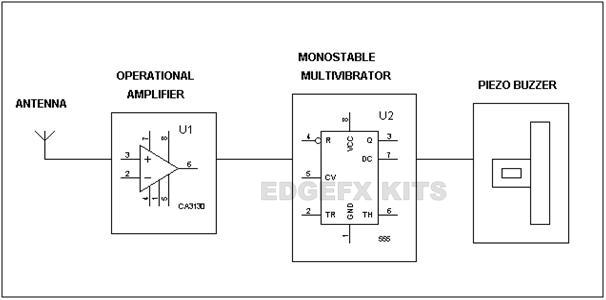
When the mobile phone signal is detected then the output of U1 becomes high and low alternately according to the frequency of the signal. This triggers mono-stable timer U2 through.
And the TR pin of 555timer goes low then pin3 of timer becomes high. When pin3 is high then the buzzer will ring.
You may use a short telescopic type antenna. The unit will give the warning indication if someone uses mobile phone within a radius of 1.5 meters.
Advantages of Cell Phone Detector:
Smaller in size
Detection of hidden cell phones
We are most familiar with cell phone active detectors. The cell phone detectors are mostly hand and pocket-size mobile transmission detectors. It can sense the presence of an activated mobile phone from a distance of one and a half meters. So it can be used to prevent use of mobile phones in examination halls, confidential rooms, etc.
Use of Cell Phone Detector:
It is also useful for detecting the use of mobile phone for spying and un-authorized video transmission. Certain places where the use of mobile phones are not allowed like exam hall, temple, offices and theaters, in those places to detect and restrict the use of mobile phones this proposed system is very helpful. The circuit can detect the incoming and outgoing calls, SMS and video transmission even if the mobile phone is kept in the silent mode.
How Cell Phone Detector Works:
The moment the bug detects RF transmission signal from an activated mobile phone, it starts sounding a beep alarm and the LED blinks. The alarm continues until the signal transmission ceases. An ordinary RF detector using tuned LC circuits is not suitable for detecting signals in the GHz frequency band used in mobile phones.
Frequency Range of Detector:
The transmission frequency of mobile phones ranges from 0.9 to 3 GHz with a wavelength of 3.3 to 10 cm. So a circuit detecting gigahertz signal is required for a mobile bug. The lead length of the capacitor is fixed at 18 mm with a spacing of 8 mm between the leads to get the desired frequency. The disk capacitor along with the leads acts as a small gigahertz loop antenna to collect the RF signals from the mobile phone.
Block Diagram and Working of Cell Phone Detector:
The circuit uses a 0.22μF disk capacitor to capture the RF signals from the mobile phone. Op-amp is used in the circuit is act as a comparator. And transistor in the input to provide very high input impedance; hence the result is in very low input current and very high speed of performance.
The output of the transistor is within 10 MV of either supply voltage terminal. The lead inductance acts as a transmission line that intercepts the signals from the mobile phone.

When the mobile phone signal is detected then the output of U1 becomes high and low alternately according to the frequency of the signal. This triggers mono-stable timer U2 through.
And the TR pin of 555timer goes low then pin3 of timer becomes high. When pin3 is high then the buzzer will ring.
You may use a short telescopic type antenna. The unit will give the warning indication if someone uses mobile phone within a radius of 1.5 meters.
Advantages of Cell Phone Detector:
Smaller in size
Detection of hidden cell phones
















